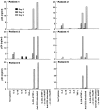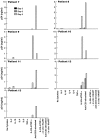Induction of HIV-1 replication in latently infected CD4+ T cells using a combination of cytokines
- PMID: 9653086
- PMCID: PMC2525548
- DOI: 10.1084/jem.188.1.83
Induction of HIV-1 replication in latently infected CD4+ T cells using a combination of cytokines
Erratum in
- J Exp Med 1998 Aug 3;188(3):following 614
Abstract
Although it has been demonstrated that certain cytokines, particularly proinflammatory cytokines, can enhance ongoing viral replication in peripheral blood mononuclear cells (PBMCs) of HIV-1-infected individuals, it is unclear what role these cytokines play in the induction of HIV-1 replication in latently infected, resting CD4(+) T cells. This study demonstrates that the in vitro combination of the proinflammatory cytokines interleukin (IL)-6 and tumor necrosis factor (TNF)-alpha together with the immunoregulatory cytokine IL-2 are potent inducers of viral replication in highly purified, latently infected, resting CD4+ T cells derived from HIV-infected individuals who are antiretroviral therapy-naive as well as those who are receiving highly active antiretroviral therapy (HAART). Viral replication induced by this combination of cytokines was completely suppressed in the presence of HAART in vitro. Given that an array of cytokines, including IL-6, TNF-alpha, and IL-2, are copiously expressed in the microenvironment of the lymphoid tissues, which harbor the latent viral reservoirs, induction of HIV by this combination of cytokines may in part explain the commonly observed reappearance of detectable plasma viremia in HIV-infected individuals in whom HAART was discontinued. Moreover, since it is likely that these infected cells die upon activation of virus and that HAART prevents spread of virus to adjacent cells, the observation that this combination of cytokines can markedly induce viral replication in this reservoir may have important implications for the activation-mediated diminution of the latent reservoir of HIV in patients receiving HAART.
Figures




References
-
- Paul WE, Seder RA. Lymphocyte responses and cytokines. Cell. 1994;76:241–251. - PubMed
-
- Fauci AS. Multifactorial nature of human immunodeficiency virus disease: implications for therapy. Science. 1993;262:1011–1018. - PubMed
-
- Poli G, Fauci AS. Cytokine modulation of HIV expression. Semin Immunol. 1993;5:165–73. - PubMed
-
- Poli, G., and A.S. Fauci. 1995. Role of cytokines in the pathogenesis of human immunodeficiency virus infection. In Human Cytokines: Their Role in Disease and Therapy. B.B. Aggarwal and R.K. Puri, editors. Blackwell Science, Cambridge, MA. 421–449.
-
- Fauci AS. Host factors and the pathogenesis of HIV-induced disease. Nature. 1996;384:529–534. - PubMed
MeSH terms
Substances
LinkOut - more resources
Full Text Sources
Other Literature Sources
Research Materials

